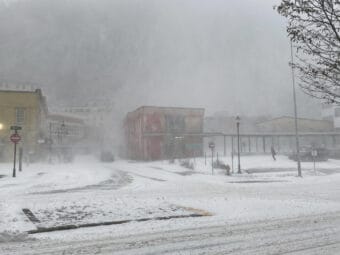
With winter creeping in across Alaska, the climate pattern known as El Niño is back and cycling warmer water through the Pacific Northwest.
National Weather Service climate researcher Brian Brettschneider — back for our Ask a Climatologist segment — says a typical El Niño winter in Alaska is often warmer and characterized by less-than-normal snowfall.
And Brettschneider says this year’s El Niño is expected to be stronger than in the past.
Listen:
The following transcript has been lightly edited for clarity.
Brian Brettschneider: It even may approach what we call a super El Niño, which has only happened a few times in the last 50 years. And those winters typically are pretty poor for snow, actually across much of the state, and particularly in the southern areas where temperatures are generally warmer in the winter than, say, the Interior. In fact, the last time we had a super El Niño develop, in 2014-15, 2015-16, those were some of our worst snow winters, lowest snow winters, on record in much of the state.
Wesley Early: You mentioned that more often than not an El Niño means a warmer winter, but it’s not always a predictor. Why would it not result in a warmer winter?
Brian Brettschneider: Right. Well, it’s really a statistical relationship. And, you know, sometimes these things don’t work out like we think they are. Sometimes the atmosphere doesn’t really, what we call, couple to the ocean. So actually right now, the atmospheric response to these warm temperatures is actually fairly weak. It’s weaker than we typically would expect. And that happens, and it’s happened in several of the more recent events, particularly the La Niñas in the last few years. There was kind of a weak relationship between how the atmosphere responded to these oceanic temperatures.
And right now, again, it’s a fairly weak coupling. And really a big unknown is globally, the oceans are much warmer than normal. And so the fact that the central Pacific is way above normal, actually needs to be put in context with what the areas around it are doing and how those warm ocean waters are also going to affect the flow of the atmosphere. So a lot of unknowns. And it can play out a lot of ways. But again, statistically, historically, it tends to drive southerly flow across the state.
Wesley Early: And how do these weather systems compare to last year, where a lot of the state was really dry and had below normal precipitation, but Anchorage saw a dump of snow — multiple dumps of snow — over a small period of time? Does it look like something similar like that would happen this year?
Brian Brettschneider: Well, precipitation is much more difficult to forecast at the monthly and seasonal timescale than temperature, by a large factor. You know, we have a temperature every day of the year. And temperature, if it’s cool in Anchorage, it’s probably cool in Palmer, it’s probably cool in, you know, King Salmon, whereas precipitation can be very, very spotty. And it only happens maybe one out of every three days. So that’s kind of a good thing to keep in mind.
And in Anchorage, I think in a 12-day period, we had kind of three almost historic snowstorms. But that was very local. If you look regionally, it was a rather unremarkable snow winter in Southcentral. Snow across the state was pretty typical for an average winter. So we do need to be cognizant of the fact that it was extremely local, a lot of kind of unusual things all conspired to come together to give us those three big snowstorms in early to mid-December.
Wesley Early: You mentioned that ocean temperatures being warmer can lead to a warmer winter, you mentioned that El Niños can lead to a warmer winter. There’s also a lot less sea ice along the coast. Does that factor into how cold the winter’s gonna be?
Brian Brettschneider: Right. So you know, a factor in the Climate Prediction Center’s seasonal outlooks is the recently late onset of sea ice along the West Coast and the North Slope. So particularly in the Chukchi Sea, working your way all the way down to the Bering Strait, sea ice sets in much later than normal, and it’s much thinner when it does. So if you get a certain type, like a southerly flow, it can really push that thin ice very far north, even in the middle of winter. And so when you don’t have sea ice over the water, it allows all the warmth from that water to be liberated into the atmosphere and that, of course, will go over the land. So the changing sea ice regime really has a large effect on temperatures, particularly in the early part of the winter.
Wesley Early: We are less than a week out from Halloween. How prepared should kids be to have to wear heavy coats over their costumes? Is it going to be a snowy Halloween?
Brian Brettschneider: Well in Fairbanks, they already have about nine or ten inches of snow on the ground. So if anyone’s listening from the central Interior, I would expect that it’s going to be full-on winter for Halloween, as it typically is. You know, up before 2015, Fairbanks had a perfect record of having snow on the ground every single Halloween, but then they didn’t for I think four out of five years. But now they’re back in the winter groove.
Historically in Anchorage, there’s about a 50-50 chance of having snow on the ground for Halloween. And that’s actually been the case for many decades, although it’s a little less snowy in the last, say, 10 or 15 years. But looking at the current outlook right now, it’s looking like we are probably not going to have a snowy Halloween in Anchorage. So probably no snow suits for the kiddos trick-or-treating.



